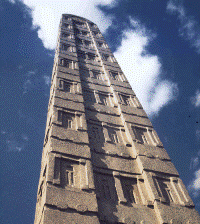Re-erection of the Ethiopian Obelisk in Aksum, Ethiopa

After the return of the Ethiopian stele, in 2005, from Italy to Ethiopia, UNESCO undertook the design for reinstallation of the Stele, an operation funded and in cooperation with the Italian government.
Background of the Aksum obelisk
The funeral stele, weighing 160 tons and standing 24 metres high, is around 1,700 years old and has become a symbol of the Ethiopian people’s identity. In 1937 this stele was taken to from Ethiopia to Italy.
The Aksum archaeological site was inscribed on the World Heritage List in 1980 and on November 18th, 2004, the governments of Italy and Ethiopia signed an agreement for the return of the Aksum obelisk, in keeping with the 1972 Convention concerning the Protection of the World Cultural and Natural Heritage.
Cooperation with UNESCO
In virtue of the named Convention, both States Parties requested UNESCO’s cooperation in returning the obelisk to its original site and Italy undertook the cost of this delicate and unprecedented operation.
Returning the obelisk
After thorough examinations, Italian experts designed the obelisk’s journey back to Aksum. Please see the photo bellow for details of the transfer.
Following its return to Ethiopia, the monument’s elaborate and complex task of assembling and positioning in an upright position was undertaken by UNESCO and funded by the Italian government. The operation started in March 2006 and is estimated to be finished by 2008. The process comprised the following steps:
Zero-risk approach
The main principle guiding this operation has been to minimize risks at all levels. The project has included a careful assessment of the environmental impacts using high tech methods to investigate the underground archaeological structures and first-class engineering solution for the re-installation.

The UNESCO Courrier (2008 - N. 8): Ethiopia: three millennia of legend and history

